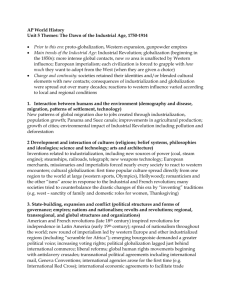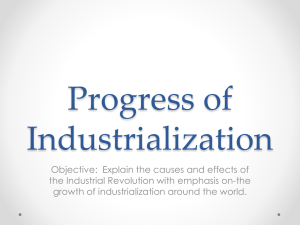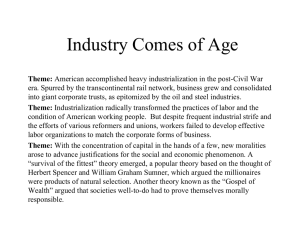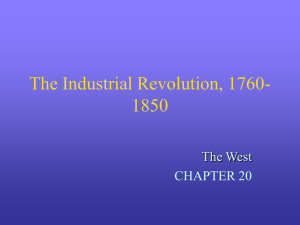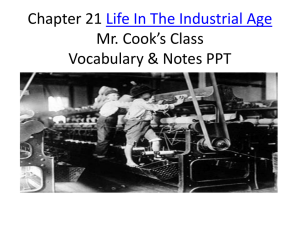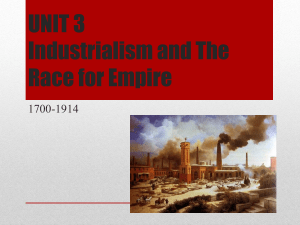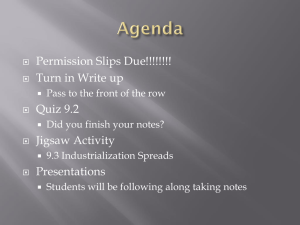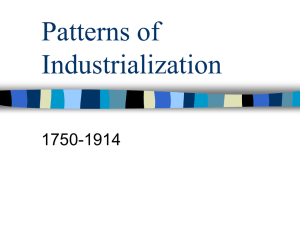Chapter 6 notes - Valley View High School
advertisement
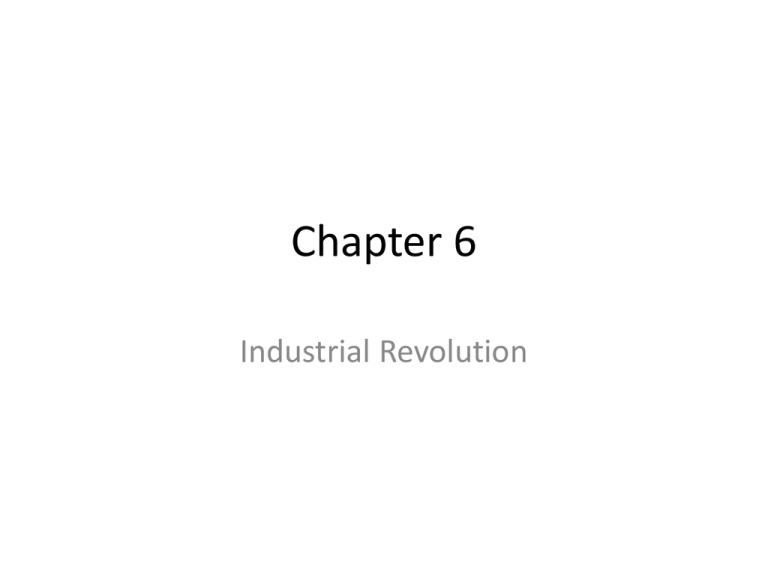
Chapter 6 Industrial Revolution Warm Up Warm- Up How did inventions like the telephone, automobile and airplane change our world? Write three complete sentences. Today’s Standard • 10.3 Students analyze the effects of the Industrial Revolution in England, France, Germany, Japan, and the United States. 2. Examine how scientific and technological changes and new forms of energy brought about massive social, economic, and cultural change (e.g., the inventions and discoveries of James Watt, Eli Whitney, Henry Bessemer, Louis Pasteur, Thomas Edison). Chapter 6 Section 1 INDUSTRIALIZATION SPREADS Industrialization Main Idea: • The factory system changed the way people lived and worked, introducing a variety of problems. Why it Matters Now: • Many less-developed countries are undergoing the difficult process of industrialization today. 6.1 Vocabulary (Write the definitions) • Dynamo • Assembly line • Stock • Corporation • Cartel Industrialization Changes Ways of Life • Industrial Revolution has both positive and negative effects. Positive Negative • Better quality of life. • Jobs were created. • Wealthy nations. • Machines cause human suffering. • Unhealthy working conditions. • Class tensions. Key factors for Industrialization • Location/Geography • Natural resources • Large supply workers • Investors • Financial systems (banks, loans) • Political stability New Industrial Powers Emerge • European countries and the United States race to industrialize. • They had more natural resources (name 2) – Coal – Iron • Great Britain paved the way • Germany and the U.S. become industrial powers – 1871 Germany becomes united – leading them to become the leading industrial power in Europe – By 1900 U.S. was manufacturing about 30% of the worlds industrial goods Industrial Development in U.S. • U.S. - more resources than Britain • Northeast industrializes first –Pittsburgh Steelers • Technological boom: 1865-1900 • Entrepreneurs eager to invest • Corporations - owned by stockholders; goal is profit Continental Europe • Germany – pockets of industrialization (spread out) –Railroads become key factor for industrialization –Imported British equipment & engineers (1830’s) –Children sent to British schools Other Industrialized Nations • Japan didn’t have resources, but became industrialized in 1868 • Russia became industrialized 100 years after Great Britain – Unstable governments and geographical conditions slow down industrialization Technology and Industrial Growth • Companies begin to hire chemists and engineers to create new products • Steel production increases – American inventor Henry Bessemer – Bessemer process – lighter, harder, more durable, & produced faster Electric Power • First seen in the late 1800’s • First simple electric motor and dynamo invented by English chemist Michael Faraday • 1870’s – Thomas Edison (American) made the first electric light bulb New Methods of production • Interchangable parts – Identical components that can be used in place of one another – Simplified both the assembly and repair of products • Assembly line – Workers add parts to a product that moves along a belt from one station to the next. – Faster, cheaper and more efficient production of goods Transportation and Communication • Automobile – aka “Horseless Carriages” – Nikolaus Otto – gasoline powered internal combustion engine – Karl Benz – first patent for automobile – Daimler introduces first automobile in 1887 – Ford takes the lead in 1900’s – makes U.S. leader in automobile industry • Airplanes – 1903 – Orville and Wilbur Wright design first plane – Plane business takes off in the 1920’s • Telephone – 1901 – Alexander Graham Bell (American) patented first phone Identify the Pictures • • • • A._______________ B._______________ C._______________ D._______________ A. B. D. C. Alfred Nobel made millions from dynamite and he donated his money to the Nobel Peace Prizes which are still awarded today. Samuel Morse’s telegraph and Morse Code along with Guglielmo Marconi’s radio were communication advances. Business Takes a New Direction • New tech. required lots of $$$$ (aka: Capital) • Owners begin selling stock – The selling of shares of a company to investors • Large scale companies (steel foundries) need more $ so they formed corporations – Businesses that are owned by many investors who buy shares of stocks. • Monopolies –began to pop up • But laws were eventually put into place to stop this to allow free market trade. Impact of Industrialization • Poor can now buy what only the rich used to be able to afford. • Widens gap between industrialized & non-industrialized nations – Western countries become very powerful – Exploitation of other countries’ resources • Desire for more resources leads to expansion (imperialism) 1. Crowded tenements and poor sanitary conditions contributed to which problem in old New York? 2. The conflict between Mayor Fernando Wood and Tammany Hall was primarily a conflict between__________ and ___________. 3. What business is John D. Rockefeller associated with? Chapter 6 Section 2 THE RISE OF CITIES 6.2 Vocabulary (write definitions) • • • • • • • Urban renewal Louis Pasteur Mutual-aid society Germ theory Robert Koch Florence Nightingale Joseph Lister Medicine Contributes to Population Growth • Between 1800 & 1900 European pop. Doubles • Result of improved nutrition, public sanitation and medical advances Medicine Advances Con’t Germ Theory – the theory that infectious diseases are caused by certain microbes. Scientists did not believe him 1870 – Louis Pasteur showed the connection between microbes and disease. He also created the vaccines for rabies and anthrax Pasteurization – a process that kills disease-carrying microbes in milk Improvements in Hospitals • 1840’s – anesthetic is used to relieve pain during surgery • Florence Nightingale improves sanitation and hygiene. • Joseph Lister – discovered how antiseptics prevented infection Identify • Below: ___________ • Left:______________ City Life Changes • Skyscrapers are built for businesses (American invention) • Streets become cleaner • Urban renewal – rebuilding of poor areas of a city. – Paved streets, sidewalks – Gas lamps, then electric lights were used to illuminate streets – Sewage systems were made • Slums remained – poorest families still forced to live in over-crowded and poorly kept tenements – Crime and alcoholism Working Class Advances • Labor Unions – workers organization – Mutual-aid societies: selfhelp groups to aid sick or injured workers • By late 1800’s workers won the right to organize • Main tactic of a union = Striking – Used to demand better working conditions – Pay, benefits, etc… Standard of living increased Labor Laws • Labor Laws were passed in several countries to force factory owners to raise the standard of living. • Pressured by unions, reformers, and working-class voters, governments passed laws to regulate working conditions. Early laws forbade employers to hire children under the age of ten. Later, laws were passed outlawing child labor entirely and banning the employment of women in mines. Other laws limited work hours and improved safety. By 1909, British coal miners had won an eight-hour day, setting a standard for workers in other countries. In Germany, and then elsewhere, Western governments established old-age pensions, as well as disability insurance for workers who were hurt or became ill. These programs protected workers from poverty once they were no longer able to work. Chapter 6 Section 3 CHANGING ATTITUDES AND VALUES 6.3 Vocabulary (write definitions) • Charles Darwin • Social gospel • Racism • Temperance movement • Women’s suffrage A New Social Order Three Social Classes Upper middle class – wealthy business owners and old aristocrats Middle Class – mid-level business people, doctors, and scientists – begins growing rapidly Lower class – unskilled workers and peasants. cult of domesticity – Idealized women and the home Women seen as tender, selfsacrificing caregiver Provides a good home Middle Class Tastes and Values Strict rules of etiquette governed… How people dressed How to give dinner parties How to pay a social call When to write letters How long to mourn relatives Women’s Rights Early Voices Women want: Fairness in marriage divorce Property laws Temperance laws Voting rights Elizabeth Cady Stanton and Susan B. Anthony Advocated the end of slavery Eventually turned their attention to women's rights. Suffrage Struggle By 1800’s some advancements had been made 1848 Seneca Falls convention Women demand the right to vote Some liberal men supported them Common arguments against women's suffrage Too emotional Women needed to be “protected” from dirty politics Women in the U.S. gain suffrage in the early 1900’s – after WWI Sojourner Truth Some critics claimed that women were too emotional to be allowed to vote. Others argued that women needed to be “protected” from grubby politics or that a woman’s place was in the home, not in government. To such claims, Sojourner Truth, an African American suffragist, is believed to have replied, “Nobody ever helps me into carriages, or over mudpuddles, or gives me any best place! And ain’t I a woman?” Growth of Public Education Public Ed. Improvements Reformers persuaded gov’ts to create public schools Teach – reading, writing and ‘rithmetic Punctuality, obedience to authority, good work habits and patriotism Industrial societies = need for literate workers By late 1800’s more children in schools Schools to train teachers were started In England schools became compulsory Primary purpose of school for women was to become better wives and mothers Higher Education Most university students = middle class Curriculum emphasized ancient history and languages, philosophy, religion and law 1840’s some colleges for women Bedford College – England Mount Holyoke – United States Identify Science Takes New Directions • Atomic Theory : – Developed by John Dalton – Each element has its own kind of atoms – Different kinds of atoms combine to make all chemical substances • New advances in Geology – earth at least 2 billion years old Darwin's theory of Natural Selection • Wrote “On the Origins of Species” • All forms of life evolved into present state over time • Natural forces “selected” those with best physical traits “Survival of the Fittest” Identify Social Darwinism & Racism Social Darwinism • Social thinkers applied Darwin's ideas to society • “Survival of the Fittest” • Only the strong are meant to lead • The most industrialized and powerful countries are meant to control the world Might = Right Racism • Unscientific belief that one racial group is superior to another • People claimed that the success of western civilization was due to the supremacy of the white race. Religion • • • • Compassion and Charity Created schools and hospitals in slums Social gospel=social service Brought about reforms in housing, health, and education • Salvation Army Chapter 6 Section 4 ART IN THE INDUSTRIAL AGE 6.4 Vocabulary • • • • • • • William Wordsworth Ludwig van Beethoven Claude Monet Vincent van Gogh Romanticism Realism Impressionism Freidrich: Cloister Graveyard in the Snow (1810) Romanticism Defined • A movement in art and ideas • A turn from reason to emotion, imagination, and freedom –Deep interest in feelings, glorification of nature, gothic horror, folk traditions, the supernatural, and the individual • A reaction against Enlightenment and the Industrial Revolution Freidrich: Cloister Graveyard in the Snow (1810) Freidrich: Man and Woman Contemplating the Moon (1830-1835) Goya: The Sleep of Reason Produces Monsters Goya: The Sabbath of Witches Saturn Devouring His Children by Francisco Goya Liberty Leading the People by Eugene Delacroix Romantic Literature • Romantic Hero – Melancholy, brooding (Ex. Jane Eyre) • Myths, legends, & Fairy Tales – – – – Often dark; castles; nationalism Grimm Brothers’ Fairy Tales Three Musketeers Hunchback of Notre Dame • Gothic Horror – supernatural, violent, emotional – Mary Shelley’s Frankenstein Romantic Music • Beethoven • Chopin Realism A reaction to Romanticism Realism Defined • Represented in art and literature • Showed life as it is (Charles Dickens) • Interest in science and scientific method – objective observation; reporting the facts – Wanted to improve the lives of unfortunates • Photography – captured the “real world” Corot: The View of Rome and the Tiber River Millet: The Gleaners Sixth-plate daguerreotype by Richard Lowe of Cheltenham 1850’s http://www.daguerre.org/ gallery/hannavy/1han.ht ml Louis Daguerre-Photographer • By the 1840s, a new art form, photography, was emerging. Louis Daguerre (dah gehr) in France and William Fox Talbot in England had improved on earlier technologies to produce successful photographs. At first, many photos were stiff, posed portraits of middle-class families or prominent people. Other photographs reflected the romantics’ fascination with faraway places. • In time, photographers used the camera to present the grim realities of life. During the American Civil War, Mathew B. Brady preserved a vivid, realistic record of the corpse-strewn battlefields. Other photographers showed the harsh conditions in industrial factories or slums. First American Daguerreotype, 1839 Stone Breakers by Gustave Courbet The Gross Clinic by Thomas Eakins Realistic Literature • Oliver Twist • Les Miserables by Hugo • Emile Zola Impressionism • Started in Paris • About not blending brush strokes • Learned that the human eye could blend the colors • Sought to capture the first fleeting impression made by a scene or object on the viewer’s eye. Claude Monet Water Lilies Claude Monet Venice Twilight Postimpressionism George Seurat


